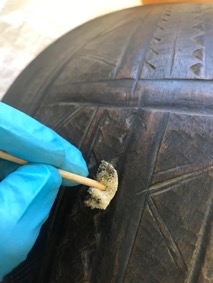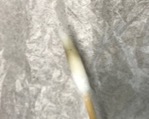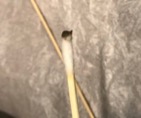A tale of mystery mould and cautious culturing – part two
30 April 2019
If you missed the first part of my blog post, you can read it here.
Treatment – Stage Two
The brush vacuuming had removed much of the visible mould on the basket and I needed to determine the next stage of treatment. The use of a 70% ethanol/water solution is common ‘to kill and disrupt the spores’ (Child, 2011 and Florian, 2002). While brush-vacuuming, tonal differences within the decoration had become clear, though it wasn’t obvious how these had been achieved, this made me apprehensive to use solvents on the surface in case there were negative reactions.
I trialled three cleaning techniques – water, 50% ethanol/50% water and smoke sponge – in a small smooth section on the base. All of these removed dirt from the surface, as seen on the cotton wool swabs, and then I tested an area of the carving. The water and cotton swab allowed me to work in the small-carved areas, but these swabs were a lot darker than the previous trial, and prompted the concern that this was removing pigments.


My preferred treatment method was to use the smoke sponge to clean the smooth surfaces, and to investigate possible pigments in the carving.
Using a portable microscope with an inbuilt camera I recorded the substances that were in the carved details- the top layers looked like dust. To further investigate the composition of the substance I used an ultraviolet light, as the elements making up the pigments become visible at different wavelengths. In the long wavelength the carved detail became a light grey colour. X-ray fluorescence was used to identify the elements present. The results for the cleaned and unclean, smooth and carved areas were similar, suggesting that cleaning hadn’t removed any surface treatment but it also hadn’t provided any certainty on what the pigments were.
Making decisions about what surface finish an object should have and when to stop cleaning it can be difficult. Have we removed all of the mould? Is this even possible when spores can land back on the surface after cleaning? I was reluctant to leave build up in the carvings as it can create microclimates where mould can reoccur. I also wanted to find evidence for the application of the 70% ethanol solution. Recent research by Sequiera et al (2017) shows that the solution does work if the material is saturated. This is not usually achieved when the solution is swabbed onto the surface. Due to the difficulty in achieving the 2-3 minutes of contact time and uncertainty regarding how the surface finish of the basket would react I decided that it would be better to continue with the smoke sponge, mechanically removing the visible dust from the surface.
References
Canadian Conservation Institute. 2017. Mould Outbreak- An Immediate Response. Available at: https://www.canada.ca/en/conservation-institute/services/preventive-conservation/mould-outbreak-immediate-response.html
Child, R. 2011. British Library Preservation Advisory Centre Booklet on Mould. London
Florian, M. L. 2002. Fungal Facts: solving fungal problems across heritage collections. London, Archetype Publications.
Sequiera, S. et al. 2017. Ethanol as an antifungal treatment for paper: short-term and long-term effects Studies in Conservation (2017).
- March 2024 (1)
- December 2023 (1)
- November 2023 (2)
- March 2023 (2)
- January 2023 (6)
- November 2022 (1)
- October 2022 (1)
- June 2022 (6)
- January 2022 (8)
- March 2021 (2)
- January 2021 (3)
- June 2020 (1)
- May 2020 (1)
- April 2020 (1)
- March 2020 (4)
- February 2020 (3)
- January 2020 (5)
- November 2019 (1)
- October 2019 (1)
- June 2019 (1)
- April 2019 (2)
- March 2019 (1)
- January 2019 (1)
- August 2018 (2)
- July 2018 (5)
- June 2018 (2)
- May 2018 (3)
- March 2018 (1)
- February 2018 (3)
- January 2018 (1)
- December 2017 (1)
- October 2017 (4)
- September 2017 (1)
- August 2017 (2)
- July 2017 (1)
- June 2017 (3)
- May 2017 (1)
- March 2017 (2)
- February 2017 (1)
- January 2017 (5)
- December 2016 (2)
- November 2016 (2)
- June 2016 (1)
- March 2016 (1)
- December 2015 (1)
- July 2014 (1)
- February 2014 (1)
- January 2014 (4)